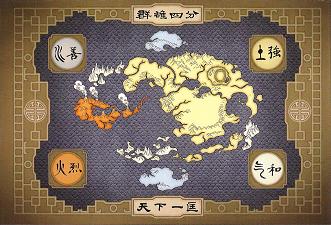ATLA: A Once in a Century Show
Credit: Nickelodeon
“Water, Earth, Fire, Air. A long time ago, the four nations lived together…” sound familiar? Winning an Emmy in 2007 for Outstanding Animated Program, “Avatar: The Last Airbender” (ATLA) is a Nickelodeon classic and is regarded by many as one of the greatest animated series of all time.
If you haven’t heard of ATLA, don’t confuse it with the movie filled with blue people, simply called “Avatar”. ATLA is a story about Aang, the Avatar, a person who has been fused with the ability to “bend” the four elements and serves as the connection between the mortal and spirit realm. He’s been frozen in ice for one hundred years and during that time, the world began to fall apart. The Fire Nation, one of four nations named after the elements in the show, had been on a tyrannical streak during his absence. They managed to destroy the entire Air Nation, except Aang, who’s the last of his people, hence the name of the show. ATLA is the story of four friends working together to defeat not just the Fire Nation, but the force of tyranny and evil throughout the world.
SPOILERS AHEAD
The show begins with two siblings, Katara and Sokka, stumbling across a giant ice block, trapped inside is the twelve-year-old Aang and his SkyBison, Appa. The block miraculously splits apart and out comes Aang and Appa, who have been stuck inside, yet preserved for one hundred years. The siblings are at first unaware with whom they have come across, but it is later revealed when Prince Zuko, crowned Prince of the Fire Nation (who had recently been banished – set to return upon his capture of the Avatar), finds him and attempts his apprehension.
Though the epic story telling isn’t the only thing that separates ATLA from other animated shows; a combination of world building, character backstory and development, and the usage of complex philosophical topics all are contained within ATLA to make it, in my opinion, the best animated show of all time.
WORLD BUILDING

Credit: Wikipedia
Four nations exist in the ATLA: The Fire Nation, The Water Tribe (Southern and Northern), The Earth Kingdom, and the Air Nomads. All the four tribes have unique and intricate backstories on how they came to be. While further explored in The Legend of Korra, (the story of the Avatar after Aang), ATLA still expands upon the history of the nations extensively. Hearing about the tragedy the Air Nomads have suffered, The Fire Nation’s tyrannical history, The Water Tribe’s separated past, and the Earth Kingdom’s sheltered culture eases the viewer into the realm of ATLA, feeling as if it is truly real and not simply a kid’s show.
CHARACTERS
The main characters of ATLA: Katara, Sokka, Aang, Zuko, Toph, undergo unique character development throughout the show. Aang is converted from a carefree boy to a full-grown Avatar, Sokka changes from a clumsy boy to a skilled fighter, Katara goes from a clueless waterbender to one of the most powerful benders of her time, and Toph turns from a stubborn tomboy to a still very stubborn tomboy, but also simultaneously learns the importance of friendship and the good of world rather than just herself. Zuko experiences the most change, he goes from an antagonistic, troubled, angry prince, determined to “win back” his honor, to a peaceful, moral leader. Uncle Iroh gets an honorable mention since he is widely regarded as one of the fan favorites. His timeless wisdom and love for tea and food makes viewers love him.
PHILOSOPHY
Perhaps the greatest element of Avatar is its ability to fit the world’s greatest philosophical and political problems into something as simple as a children’s show. It addresses several of the following: The ethics and effects of war, killing the defenseless, tyranny, propaganda, shadow governments, loyalty to friends, genocide, the thirst for power, revenge and so much more. Every episode is an implicit commentary on some social, moral, or political issue, yet it’s done in an unbiased and delicate way making the show timeless.
By watching ATLA you’re getting a philosophical, cultural, animated masterpiece wrapped into what’s formally known as a children’s show (that doesn’t feel like one). If you haven’t seen it, I highly recommend watching!

